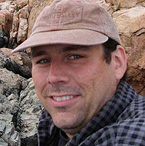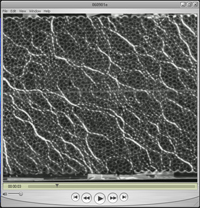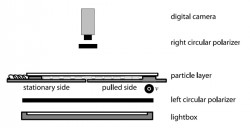Tabletop Earthquakes: Visualization Tool Might Solve Real-World Mysteries
January 2, 2009

Earthquake researchers have made great strides in their quest to understand the processes that generate earthquakes and control their severity. They record seismic waves, measure ground motion, run computer simulations, and look for signs of past quakes in seafloor sediments. And of course even non-scientists see the devastating effects from shaking at the surface. But what if scientists could see up close the underground processes that trigger quakes?
As postdoctoral researchers at Duke University, Nick Hayman and Karen Daniels wanted to create miniature earthquakes in a laboratory to help solve lingering mysteries about what factors cause earthquakes to happen when and where they do and what controls their size. Earthquakes happen as tectonic plates move past one another, but what happens in those interfaces between plates—called fault zones—is uncertain. There are many ways for faults to fail: fluids can build up pressure, small patches of high friction can slip creating small earthquakes, or entire plate boundaries can slip in one event, as happened in Sumatra in 2004.
Hayman and Daniels suspected that a poorly understood factor—the size, shape and composition of tiny granular materials in the crust—might play a significant role in generating earthquakes. Proving this role might be critical in assessing earthquake hazards to human populations in places such as southern California.

So here is what they did. To represent the Earth’s crust—the rocks and sand and other grains of material beneath our feet—they chose round plastic discs about the size of lentils.
To mimic the motion of tectonic plates that generate stick-slip earthquakes such as those produced along California’s San Andreas Fault, they arranged 8,000 of the discs in a single layer on top of two Plexiglas plates that were free to slide past each other. To seal it all up in a closed cell, they added sidewalls and another layer of clear Plexiglas on top. They attached a spring to one bottom plate and hung a weight from it off the edge of the table. This pulled the plate at a constant velocity past the stationary plate. The friction of the discs rubbing past each other at the plate boundary produced a force on other nearby discs.
The whole thing sat on top of a light table so that light passed right through the cell and the grains. Having a clear top and bottom and just one layer of discs allowed them to film everything in minute detail with a high resolution digital camera. Watch a video.
One other nifty feature allowed them to do even more interesting things. By placing polarized filters between the camera and their earthquake model, they could measure the forces experienced by each grain inside the cell. That’s because the discs exhibit birefringence, a physical property that causes light passing through them to become polarized as the discs are squeezed. Areas that appeared bright white were experiencing significant stress, whereas grains that remained dark experienced relatively little stress. The filamentous bright areas, indicating how stress propagates across a group of grains, are known as force chains.

Watching one of their videos, the viewer gets a real intuitive sense of how stresses are transmitted through grains near a fault. The view is from above. The fault, corresponding to the boundary between the two sliding bottom plates, runs horizontally across the middle of the video. Over the course of several minutes—condensed into one minute for this video—there are hundreds of simulated earthquakes. Force chains appear, move, rearrange and vanish. Interestingly, a pile of apples exhibits force chains such that some apples experience more of the weight of the overlying pile than others.
Hayman, now a researcher at the Jackson School of Geosciences at the University of Texas at Austin, envisions using this setup to communicate to the public what happens during a real earthquake. He’s building a similar earthquake model at the Jackson School for new experiments and for use in teaching undergraduate and graduate courses in physics and earth science.
“What’s particularly exciting about this project is that there are so few ways of getting an image of what’s happening in earth science,” said Hayman.
Hayman and Daniels discovered that in their setup, the sizes of slip events (analogous to earthquake magnitudes) followed a power law, meaning that the more energetic an event, the number of events with the same amount of energy dropped off rapidly. This was the same distribution discovered by Beno Gutenberg and Charles Francis Richter in real world earthquakes and forms the basis of the Richter scale. In most cases, this means that there are a tenth as many magnitude 5 earthquakes as magnitude 4’s, a tenth as many magnitude 6’s as magnitude 5’s, and so on up the scale.

They reported their findings in the Journal of Geophysical Research on November 26, 2008.
Hayman and Daniels believe the similarities to natural earthquakes support the idea that tiny grains do have an impact on when and where earthquakes occur and on their sizes.
“What our experiment is showing is that some of the fundamental distributions of earthquakes that are known in nature can be mimicked using just granular materials,” said Hayman. “And the fact that we can observe the state of stress enhances the point of view that these materials are important in faults.”
Hayman plans to see how changing the grain sizes or adding fluids affects the results. He also plans to compare the force chains he and Daniels imaged to natural structures in geologic faults. And for now, their tabletop simulations may be the closest scientists and the public can get to seeing an earthquake with their own eyes.
by Marc Airhart
For more information about the Jackson School contact J.B. Bird at jbird@jsg.utexas.edu, 512-232-9623.
